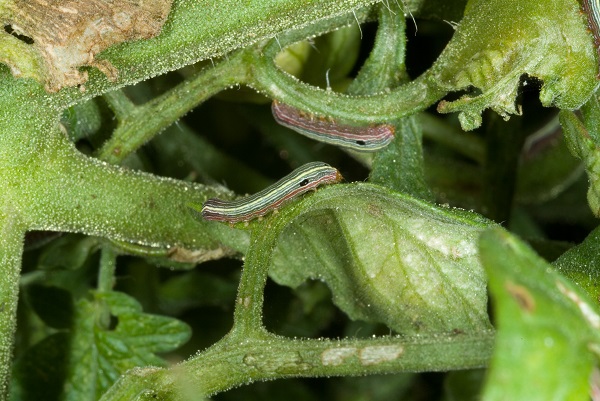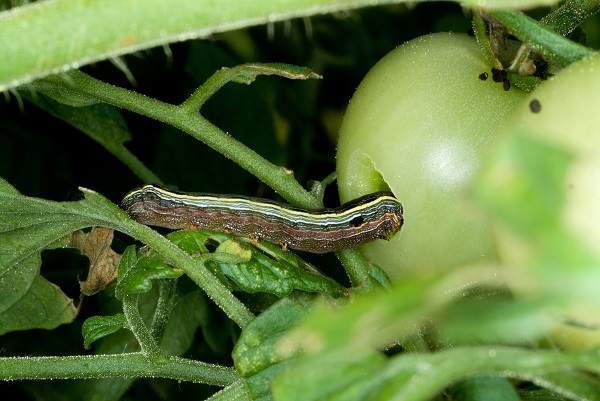Yellowstriped Armyworm
ENTFACT-321: Yellowstriped Armyworm | Download PDF
Ric Bessin, Extension Specialist
University of Kentucky College of Agriculture
Yellow-striped armyworm is a common pest of many vegetable crops in Kentucky including greens, tomatoes, peppers, beans, cucurbits and cole crops. It also attacks tobacco, soybeans, corn, and alfalfa. While it is primarily a foliage feeder and can seriously injury young plants in the early season, later in the season it will also feed in the surface of tomato and pepper fruits as well as foliage.

Figure 1. Yellow-striped armyworm is a very common vegetable insect pest.
The larva can be common in some years and is distinct in appearance. The body varies from dark grey to black in color with two prominent yellow stripes along each side. Below this yellow stripe there are other less distinct stripes including a pink stripe above the prolegs. Two dark triangles may be apparent on the top of each segment. There may be a noticeable dark spot above and behind the hind legs, but this can be difficult to see on darker larvae. There is an inverted white ‘Y’ on the dark head capsule with a netlike pattern. The larva can reach 1-3/4 inches in length.
Yellow-striped armyworm overwinters as a pupa in the soil and emerges as a moth in April and May. The female moth lays her eggs in clusters of 200 to 500 on the undersides of leaves. A single female may deposit more than 2000 eggs. Eggs hatch in 5 to 7 days and the larvae feed for about 3 weeks before returning to the soil to pupate. There are three to four generations during the year in Kentucky with the mid-summer generations being more common.

Figure 2. Young yellow-striped armyworm larvae feeding on tomato foliage.
Management
As with other armyworm species, it is much easier to control small larvae as larger stages are more tolerant of some insecticides. Therefore, transplanted crops and young plants should be monitored regularly for early detection of yellow-striped armyworm. Insecticides listed for corn earworm are generally effective against small larvae while those listed for beet armyworm may be more effective against larger stages.

Figure 3. Larger yellow-striped armyworm larvae feed in tomato fruit.
Yellow-striped armyworms have natural enemies in the field including parasitic wasps and flies. There is also a naturally occurring nuclear polyhedrosis virus that attacks yellow-striped armyworm periodically.
Issued: 11/19
CAUTION! Pesticide recommendations in this publication are registered for use in Kentucky, USA ONLY! The use of some products may not be legal in your state or country. Please check with your local county agent or regulatory official before using any pesticide mentioned in this publication.
Of course, ALWAYS READ AND FOLLOW LABEL DIRECTIONS FOR SAFE USE OF ANY PESTICIDE!
Photos courtesy Ric Bessin, University of Kentucky Entomology
